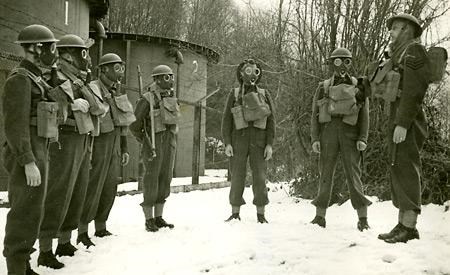by Kyle Wells [email protected] Seventy years ago, at the beginning of 1941, World War II was quietly simmering but getting ready to break open, the Nazis were at their height of power and Powell River residents were doing their part.
For the moment the fighting in Europe was quiet, as the Nazis controlled most everything including France, Italy, all of eastern Europe and much of Scandinavia. Having been forced off mainland Europe at Dunkirk in May 1940, the British and their allies were fighting the enemy primarily in North Africa, the Balkans and in Syria-Lebanon. London and other cities in the United Kingdom were devastated in 1941 during the heaviest period of the Blitz.
In March 1941 the Germans invaded Greece, forcing allies to retreat to the island of Crete, where they would again face and lose to the Germans in May. Field Marshal Erwin Rommel arrived in North Africa in February 1941 to begin the German counterattack to British and allied advances made against the Italians. On June 22 the Germans attacked the Soviet Union and were soon enmeshed in the siege of Leningrad, a standoff that would last nearly 900 days and cost more lives than any other battle in that or any other war of the 20th century.
Back in Powell River the war effort was heating up, local men and women were getting involved and many men were being sent overseas to take part in the allied campaigns.
Newspapers from the day spoke of the many war-related activities that were taking place in Powell River. In August 1941 the Red Cross fruit conservation committee made 1,216 pounds of plum and blackberry jam over three weeks to be sent to soldiers in England. On November 20 a Powell River Town Crier headline read “Ladies can go after Hitler with a rolling pin” for an article about a call from the Department of National War Services for 300 cooks.
A civilian protection committee was formed to coordinate defence efforts and ready Powell River for attack, which was a very real concern with tensions with Japan strengthening. Homes were made blackout ready so that they would not reveal light in the case of a bombing attack. Recruitments were ongoing at the “Old Gymnasium building.”
“How many of the [300] and more young fellows from Powell River, now in His Majesty’s Canadian Forces, are destined to fight, and die, in order that Freedom may not perish from this earth?” asks a November 13, 1941 Powell River News editorial. “Powell River citizens must not fail their fathers, sons and brothers who have offered their very lives.”
A column in the News titled Canada’s War Record on September 18 looked at Canada’s contribution to the war by that time. After two years at war the number of Canadians in the military had risen from 68,000 to 490,000. More than 100,000 Canadian soldiers, sailors and airmen were stationed in the United Kingdom. Many airmen were involved in battles over the United Kingdom, Europe and elsewhere, while the Navy fought in the waters of the Atlantic. By then 1,200 Canadians were killed or missing in action.
To support the war Canada was spending between $3 million to $4 million per day. Canadians paid heavier taxes to support the war effort and purchased nearly $1.5 billion worth of war bonds and savings. War production brought in hundreds of millions of dollars, however, and throughout the country factories were being built and everyone, including, for one of the first times, women, were going to work for the war.
Mackenzie (which included Powell River) MP Flying Officer James Sinclair visited Powell River just prior to Labour Day 1941 before leaving for service overseas. He spoke to a crowd about his support of conscription for labour in the industrial war effort and stated that a desired breakwater in Westview would have to wait until after victory. Sinclair went on to fight in North Africa and the Mediterranean and remained an MP until 1958. His daughter, Margaret Joan Sinclair, would go on to gain notoriety as Margaret Trudeau, wife of Pierre Trudeau.
For some the war offered the first opportunity to leave Powell River and see the world.
On September 30, 1941 the Powell River News published an article describing a Royal Canadian Air Force wireless operator from Powell River’s first ever flight during training in England.
“Do you know what it feels like to go zooming into the air for the first time in an aeroplane?” reads the article. “If not you should read this article in which LAC Peter Grain, son of Mr. and Mrs. C.W. Grain of Westview...describes his first flight.”
In the article Grain describes the great “upsy-daisy” sensation he felt aboard the plane as he is taken along for some target practice and describes the sound of the machine guns with the plane’s engines as being “as a troop of monkeys would chatter at a charging herd of wild elephants.”
Unfortunately, the war also brought tragedy for many. On October 16 the Powell River News reported that two former residents of Powell River had been either killed or taken prisoner during the Battle of Crete. Archie Prentice and James McAuley were described as being unofficially reported to have been killed. A third man, Oliver Johnson, McAuley’s cousin, from Cranberry was wounded in the fighting but managed to escape to Egypt by plane.
Even as war raged Remembrance Day ceremonies continued. People in Powell River gathered then as they do now at the cenotaph outside of Dwight Hall to remember the fallen and honour those currently involved in conflicts. Nearly 400 gathered in 1941 for the presentation of flags, the singing of hymns and the reading of “In Flanders Fields.”



